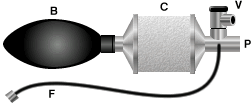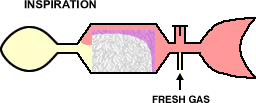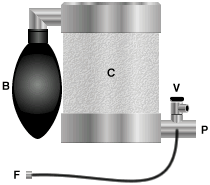 |
||||||||||||||||||
|
|
|
Waters' Canister Construction
A carbon dioxide absorber canister (C) is connected to a breathing bag (B), the fresh gas supply (F), the patient (P) and a pressure-relief valve (V). Function
The patient breathes to-and-fro into the circuit. Expired carbon dioxide is absorbed by the soda-lime. Excess gas is vented when necessary via the pressure-relief valve. One problem with the original horizontal canister is that, unless it is tightly packed, the soda-lime tends to settle and allow channeling of the gas above the granules:
This can lead to substantial rebreathing and can be avoided by ensuring that the soda-lime is tightly packed using a nylon pot scrub pad. An alternative, and superior, approach usually used in large animal systems is to use a vertical canister so that channeling cannot occur:
Operational requirements
Advantages
Disadvantages
Uses |
Comments on this
article should be addressed to Dr Guy
Watney
All pages © Anesthesia Service
and Equipment 1998-2003.



